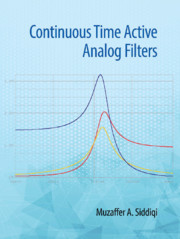Book contents
- Frontmatter
- Dedication
- Contents
- Preface
- Acknowledgments
- 1 Analog Filter: Concepts
- 2 First-and Second-order Filters
- 3 Magnitude Approximations
- 4 Delay: Approximation and Optimization
- 5 Frequency and Impedance Transformations
- 6 Sensitivity of Active Networks
- 7 Single Amplifier Second-order Filters
- 8 Multi Amplifier Second-order Filter Sections
- 9 Direct Form Synthesis: Element Substitution and Operational Simulation
- 10 Cascade Approach: Optimization and Tuning
- 11 Amplification and Filtering in Biomedical Applications
- 12 Audio Signal Processing and Anti-aliasing Filters
- 13 Follow the Leader Feedback Filters
- 14 Switched Capacitor Circuits
- 15 Operational Transconductance Amplifier-C Filters
- 16 Current Conveyors and CDTA (Current Differencing Transconductance Amplifiers) Based Filters
- 17 Active R and Active C Filters
- Index
- References
9 - Direct Form Synthesis: Element Substitution and Operational Simulation
Published online by Cambridge University Press: 24 December 2019
- Frontmatter
- Dedication
- Contents
- Preface
- Acknowledgments
- 1 Analog Filter: Concepts
- 2 First-and Second-order Filters
- 3 Magnitude Approximations
- 4 Delay: Approximation and Optimization
- 5 Frequency and Impedance Transformations
- 6 Sensitivity of Active Networks
- 7 Single Amplifier Second-order Filters
- 8 Multi Amplifier Second-order Filter Sections
- 9 Direct Form Synthesis: Element Substitution and Operational Simulation
- 10 Cascade Approach: Optimization and Tuning
- 11 Amplification and Filtering in Biomedical Applications
- 12 Audio Signal Processing and Anti-aliasing Filters
- 13 Follow the Leader Feedback Filters
- 14 Switched Capacitor Circuits
- 15 Operational Transconductance Amplifier-C Filters
- 16 Current Conveyors and CDTA (Current Differencing Transconductance Amplifiers) Based Filters
- 17 Active R and Active C Filters
- Index
- References
Summary
Introduction
In the previous chapters, we studied realization of first-order and second-order filter sections. Though these filter sections are used as such, they are also used to generate higher-order filters employing different processes including the cascade process. However, a common alternate process for realizing second- or higher-order filter section is the direct form of synthesis. There are two broad categories in the direct form of synthesis: (i) element substitution method and (ii) operational simulation method. Though the filter realization procedures in the aforementioned categories differ, the starting point is the same. Initially, a passive structure with element values (mostly frequency and impedance normalized) is obtained. It is then converted into its active form. Although they have the same starting point, the construction and characteristics of the active circuit obtained through the direct form and that obtained through the cascade form differ on many counts, as shall be illustrated later.
The most common passive structure that is used to realize passive filters is the doubly terminated lossless ladder. A typical lossless ladder is shown in Figure 9.1 where Rin and RL are the terminating resistors and the ladder contains only lossless elements, that is, inductors and capacitors; each series and shunt branch of the ladder can be any combination of inductors/capacitors.
We will first discuss the element substitution type of direct form synthesis procedure, which is mainly the avoidance of the use of inductors. Therefore, simulation of inductors forms an important part of the chapter. Inductance simulation, configurations for inductance simulation and active filter realizations without using an inductor are discussed in Sections 9.2–9.5. Section 9.6 deals with the simulation of a floating inductance, mainly through using two circuit structures of grounded inductances. Another method in which the inductor can be eliminated from the general lossless ladder is through scaling of the structure by the complex frequency variable s. This method generates a new type of element called the frequency dependent negative resistance (FDNR). As simulation of inductors and FDNR requires impedance conversion configurations, it is important to study the basics of these concepts. The technique is included in Section 9.8.
- Type
- Chapter
- Information
- Continuous Time Active Analog Filters , pp. 244 - 298Publisher: Cambridge University PressPrint publication year: 2020



